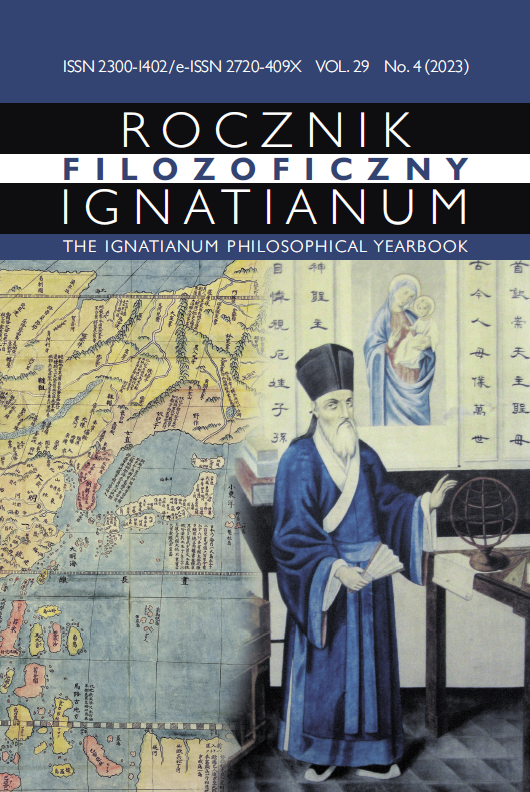Gravissima pericula
Rok 1606 jako brzemienny w wydarzenia dla zakonu jezuickiego w świetle dziejów powszechnych oraz Historiae Sinarum Imperii Tomasza Szpota Dunina (1644–1713)
Abstrakt
Artykuł analizuje opis roku 1606, który wyszedł spod pióra Tomasza Szpota Dunina SJ (1644–1713) w Historiae Sinarum Imperii (ARSI, Jap. Sin. 102), w szerszym kontekście historycznym, uwzględniając perspektywę lokalną oraz globalną. Szpot porządkuje narrację chronologicznie, opierając się na periodyzacji rocznej, która łączy chronologię zachodnią, liczoną od narodzin Chrystusa, z chińskim systemem datowania powiązanym z Mandatem Nieba, sprawowanego przez poszczególnych cesarzy wybranej dynastii. Jego dzieło obejmuje schyłek rządów Mingów i wczesne panowanie Qingów. Nie ulega wątpliwości, że działalność zakonu jezuitów podlegała w tym czasie dynamicznej ewolucji i modyfikacji, co było wynikiem szeregu kryzysów, z którymi musiał zmagać się zakon podczas swej działalności w Chinach. Najważniejsze z nich przypadają na lata 1606, 1616–1617, 1661–1671, 1706–1710, 1715–17242. Szpot podkreśla, że ich przyczyną były zazwyczaj napięcia w obrębie koterii dworskich, które rykoszetem odbijały się na działalności misyjnej. Tym niemniej kryzys 1606 r. był innego rodzaju, gdyż wywołali go sami misjonarze. Indywidualna zawiść i osobiste ambicje, nabrzmiewające od kilku lat we wspólnocie katolickiej Makau, wybuchły pełnym płomieniem nienawiści, donosu i zdrady, stanowiąc śmiertelne zagrożenie dla dalszej działalności misjonarzy jezuickich stacjonujących w Państwie Środka.
Bibliografia
Dell’historia della Compagnia di Giesú. La Cina. Terza parte dell’Asia descritta dal P. Daniello Bartoli, della medesima Compagnia (Roma, 1663).
Epitome Historiae Societatis Jesu auctore Josepho Juvencio eiusded societatis sacerdote, t. 4. Ab anno Christi MDLIII ad annum MDCXVI (Gandavi, 1853).
Fonti Ricciane: Storia dell’introduzione del Cristianesimo in Cina, red. Pasquale
M. d’Elia, t. 1-3 (Roma: La Libreria dello Stato, 1942–1949).
China in the Sixteenth century: The Journals of Matthew Ricci, 1583–1610, tłum.
Louis J. Gallagher (New York: Random House, 1953).
The Works of John Dryden, t. 1: Poems 1649–1680, red. Edward N. Hooker,
H.T. Swedenborg Jr, (Berkeley–Los Angeles–London: Clarendon Press, California University Press, 1956).
Kottman Jr Karl A., António Vieira’s Preliminary Book to the „History of the Future”. Original Reading (San Francisco (CA): Lulu Publishing Services, 2008).
Alessandro Valignano S.I. uomo del Rinascimento: Ponte tra Oriente e Occidente, a cura di Adolfo Tamburello, M. Antoni J. Ücerler S.J., Marisa Di Russo (Roma: Institutum Historicum Societatis Iesu, 2008).
Biographical Dictionary of Christian Missions, red. Gerard H. Anderson, William
B. Eerdmans (Grand Rapids (Mi)–Cambridge (UK): Publishing Company, 1999).
Boxer Charles R., The Christian Century in Japan 1549–1650 (Berkeley–Los Angeles: University of California Press, 1951).
Brockey Liam Matthew, Journey to the East. The Jesuit Mission to China 1579– 1724. (Cambridge (MA)–London: Harvard University Press, 2007).
Cooper Michael, The Japanese Mission To Europe 1582–1590: The Journey of Four Samurai Boys Through Portugal, Spain and Italy (Global Oriental, 2005).
Costa Horacio de la, S.J., The Jesuits in the Philippines 1581–1768 (Cambridge– Massachusetts: Harvard University Press, 1961).
Dehergne Joseph, Répertoire des Jésuites de Chine de 1552 à 1800 (Roma–Paris: Institutum Historicum S.I, Letouzey et Ané, 1973).
Dictionary of Ming Biography 1368–1644, red. L. Carrington Goodrich, Chaoying Fang (New York–London: Columbia University Press, 1976).
Dunne George H., Generation of Giants. The Story of Jesuits in China in the Last Decades of the Ming Dynasty (Notre Dame (IN): University of Notre Dame Press 1962).
Fontana Michela, Matteo Ricci. A Jesuit in the Ming Court, tłum. Paul Metcalfe (New York–Toronto: Rowman & Littlefield Publishers, Inc., 2011)
Gernet Jacques, China and the Christian Impact. A Conflict of Cultures (Cambridge–London: Cambridge University Press, 1985).
Gernet Jacques, Chine et christianisme. Action et réaction (Paris: Gallimard, 1982).
Guillen-Nuñez Cesar, Macao’s Church of Saint Paul. A Glimmer of the Baroque in China, (Aberdeen–Hong Kong: Instituto Cultural do Governo da R.A.E de Macau Hong Kong University Press, 2009).
Huang Ray, 1587. A Year of No Significance. The Ming Dynasty in Decline (New Haven–London: Yale University Press, 1981).
Keul Istvàn, Early Modern Religious Communities in East-Central Europe. Ethnic Diversity, Denominational Plurality, and Corporative Politics in the Principality of Transylvania (1526–1691) (Leiden–Boston: Brill, 2009).
Kochowski Wespazjan, Historya panowania Jana Kazimierza, t. 3 (Poznań:
N. Kamieński i Spółka, 1859).
Kościelak Sławomir, Jezuici w Gdańsku od drugiej połowy XVI do końca XVIII wieku (Gdańsk–Kraków: Gdańskie Towarzystwo Naukowe – Wydawnictwo WAM, 2003).
Kottman Karl A. Jr., António Vieira’s Preliminary Book to the „History of the Future”. Original Reading (San Francisco (CA): Lulu Publishing Services, 2008).
McCoy Alfred W., To Govern the Globe. World Orders and Catastrophic Change
(Chicago: Haymarket Books, 2021).
McHugh Evan, 1606. An Epic Journey (Sydney: University of South Wales Press, 2006).
Oxnam Robert B., Ruling from Horseback. Manchu Politics in the Oboi Regency 1661–1669 (Chicago–London: The University of Chicago Press, 1970).
Petersson Andreas Mazetti, A Culture for the Christian Commownealth. Antonio Possevino, Authority, History, and the Venetial Interdict (Uppsala: Uppsala Universitet, 2022).
Schurz William Lytle, The Manila Galleon (New York: E. P. Dytton and Co., 1939). Schütte Josephus Franciscus, Introductio ad historiam Societatis Jesu in Japonia 1549–1650. Ac prooemium ad catalogos Japoniae edendos ad edenda Societatis Jesu Monumenta Historica Japoniae Propylaeum (Romae: Institutum
Historicum Societatis Jesu, 1968).
Shapiro James, The Year of Lear. Shakesperae in 1606 (London: Faber & Faber, 2016).
Spence Jonathan, The Memory Palace of Matteo Ricci (London–Boston: Faber & Faber, 1985).
Tang Kaijian, Setting off from Macau: Essays on Jesuit History During the Ming and Qing Dynasties (Leiden–Boston: Brill, 2016).
The Jesuits and Globalization: Historical Legacies and Contemporary Challenges, red. Thomas Banchoff and José Casanova (Washington: Georgetown University Press, 2016).
Üçerler M. Antoni J., The Samurai and the Cross. The Jesuit Enterprise in Early Modern Japan (Oxford–New York: Oxford University Press, 2022).
Wills John E., Jr., 1688. A Global History (New York–London: W.W. Norton & Company, 2001).
Załęski Stanisław SJ, Jezuici w Polsce, t. 1: Walka z różnowierstwem 1555–1608
(Lwów: Drukiem i Nakładem Drukarni Ludowej, 1900), 587–620.
Borao Jose Eugenio, “The Massacre of 1603: Chinese Perception of the Spaniards in the Philippines”, Itinerario 23/1 (1998): 22–39.
Dodson-Robinson Eric, “Karma, Revenge, Apocalypse: Ran Violent Victim-
-Agent through Japanese and Western Contexts”, Shakespeare Bulletin 31/2 (2013): 233–255.
Maxwell Kenneth, “Macao: The Shadow Land”, World Policy Journal 16/4 (1999/2000): 73–95.
Meynard Thierry, “For the Record: The Canton Exile of the Missionaries (1666– 1671) by the Polish Jesuit Szpot Dunin”, Annales Missiologici Posnanienses 25 (2020): 147–185.
Pavone Sabina, “Banishment, Exile and Opposition: Jesuit Crises before the 1760s”, Lusitania Sacra 32 (2015): 105–119.
Pavone Sabina, “The Deceivers Deceived: How a Seventeenth-Century Venetian Anti-Jesuit Circe Duped a Jesuit Rector”, Journal od Jesuit Studies 10 (2023): 45–62.
Słoczyński H. Marek, „Kazanie Piotra Skargi Jana Matejki w kontekście ówczesnej wiedzy o epoce i poglądów na dzieje Polski”, Folia Historica Cracoviensia 24/1 (2018): 59–116.
Tronu Carla, “The Rivalry between the Society of Jesus and the Mendicant Orders in Early Modern Nagasaki”, Agora: Journal of International Center for Regional Studies 12 (2015): 25–39.
Truong Anh Thuan, “The Conflicts Among Religious Orders of Christianity in China During the 17th and 18th Centuries”, Религиозные аспекты регионоведения 26/5 (2021): 57–71.
Ward Haruko Nawata, “Jesuit Encounters with Confucianism in Early Modern Japan”, Sixteen Century Journal 40/4 (2009): 1045–1067.
Woo Franklin J., “Liam Matthew Brockey. Journey to the East: The Jesuit Mission to China 1579–1724”, China Review International 15/3 (2008): 363–370.
Berlin Isaiah, “The Hedgehog and the Fox”, w: Russian Thinkers, red. Henry Hardy, Aileen Kelly (London: Penguin Books, 1978).
Danieluk Robert, „Konfesjonał i pióro: Tomasz Ignacy Szpot Dunin, polski historiograf jezuickiej misji w Chinach”, w: Iesuitae in Polonia – Poloni Iesuitae. Piśmiennictwo łacińskie czasów nowożytnych, red. Jarosław Nowaszczuk (Szczecin: „Volumina.pl”, 2017), 75–108.
Fletcher Joseph F., “Integrative History: Parallels and Interconnections in the Early Modern Period 1500–1800”, w: Studies on Chinese and Islamic Inner Asia, red. Beatrice Forbes Manz (Aldershot: Variorum, 1995).
Malatesta Edward J., S.J., “A Fatal Clash of Wills: The Condemnation of the Chinese Rites by the Papal Legate Carlo Tomasso Maillard de Tournon”, w: The Chinese Controversy. Its History and Meaning, red. David Emil Mungello (Sankt Augustin–San Francisco: Institut Monumenta Serica and The Ricci Institute for Chinese-Western Cultural History, 1994).
Copyright (c) 2023 Uniwersytet Ignatianum w Krakowie

Utwór dostępny jest na licencji Creative Commons Uznanie autorstwa 4.0 Międzynarodowe.
Rocznik przyjmuje do druku wyłącznie materiały, które nie wchodzą w żaden konflikt interesów, żaden konflikt z prawem autorskim itp. Redakcja prowadzi działania przeciw: plagiatom, ghostwriting1, guest/honorary authorship2 itp. Autor pracy zbiorowej, który jest pierwszy na liście, bierze na siebie odpowiedzialność i ma obowiązek przedstawić wkład wszystkich współautorów. Jeśli publikacja powstała dzięki dedykowanym środkom finansowym, należy ujawnić to np. w Podziękowaniu, przypisie itp. Ew. przedruki wymagają jawnego zgłoszenia i okazania odpowiedniego pozwolenia wydawniczego. Autorzy / Recenzenci nierzetelni narażają się na reakcję właściwą stosownym instytucjom.
______
1 Ma to miejsce, gdy osoba mająca istotny wkład jest pominięta na liście Autorów czy w Podziękowaniu.
2 Zachodzi, gdy na liście autorskiej pojawia się osoba mająca znikomy/żaden udział w pracy.





